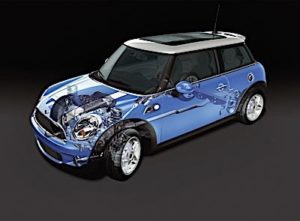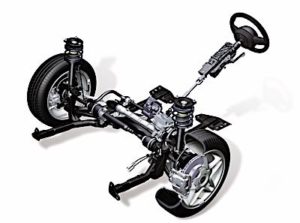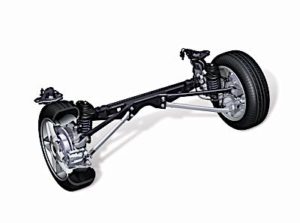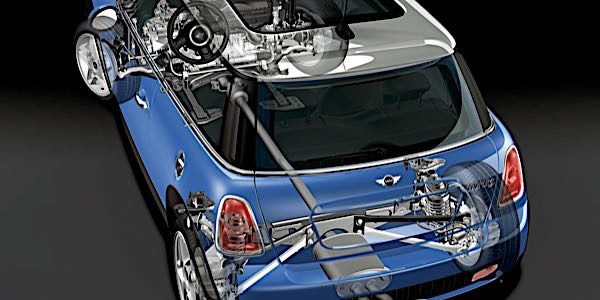When BMW bought the assets of Rover in 1994, it purchased the iconic MINI brand as well. In 2001, BMW introduced the first completely new MINI in more than 40 years. The modern MINI was a more of a tribute to the previous MINI rather than a continuation of the British icon.
Is it a BMW? Yes and no. The platform for the MINI is not shared with any other BMW. But, a lot of the diagnostic tools, software and service information have all the trademarks of a BMW.
With more than a million MINIs on the roads, a lot of opportunity exists for shops to service brakes and chassis.

Ordering Parts
When ordering parts for a MINI, the model and year are just as important as knowing the R-series model number. The R-number is a carryover from the original Rover series.
R50: “Mk I” MINI One & Cooper (2002-‘06)
R52: “Mk I” MINI Convertible (2004-‘08)
R53: “Mk I” MINI Cooper S (2002-‘06)
R55: “Mk II” MINI Clubman (2007-‘14)
R56: “Mk II” MINI Hatch/Hardtop (2006-‘13)
R57: “Mk II” MINI Convertible (2009-present)
R58: Coupé (2012-present)
R59: Roadster (2012-present)
R60: Countryman (2010-present)
R61: Paceman (2013-‘16)[58]
F56: MINI Hatch/Hardtop (2014-present)[59]
F55: 5-door Hatch (2015-present)
Brakes
Servicing the mechanical parts of the brakes is straightforward, but there are a few interesting items that are unique to MINIs.
The first unique item is the parking brake on 2002-‘06 models can cause the brakes to drag. The parking brake cable on the lower control arms can be come dislodged and bent. This can prevent the rear caliper from fully retracting.
Another issue MINI’s braking systems can face is with its braking algorithms. The MINI estimates the thickness of the brake pads using an algorithm that takes into account the number of stops, the g-forces generated, and other data from the ABS system.
The yellow “Service Due” warning message lights up in the instrument cluster, even though the brake pad thickness is more than 4.2mm (above the thickness at which the pad sensor intervenes). MINIs also have wear sensors on the inboard pads that alert the driver to when the friction material has dropped below 2mm.
The calculated remaining service life for the brake pads (front or rear axle) from the data might not match the actual brake pad thickness. BMW’s remedy for this problem is to reprogram the algorithm so the warning light does not come on too soon. Check the service information to see if there is a new calibration for the vehicle.
On 2002-‘06 models, turn the ignition key to the #2 position for around 30 seconds without turning over the engine. For later models it involves a series of button pushes and navigating menus in the driver information center.
It is always a good idea to reset the system when the brake pads are replaced.
Front Suspension
On MINI models, the main culprit of front suspension problems is lower control arm bushings. The second most common failure is the upper strut mounts. Both component failures can result in poor alignment and noise.
The 2002-‘13 models have a conventional strut front suspension. In 2007, BMW redesigned the MINI to make it wider and improve the geometry of the rear suspension so it could accommodate a differential and axles for an all-wheel-drive system.

The MINI uses four hydraulic bushings. In the front, the hydraulic bushing is located at the rear of the control arms. In the rear, the hydraulic bushing mounts the trailing arm to the body. These mounts can leak when they fail. The camber and toe will change when the bushings go soft. BMW recommends replacing the bushings in pairs.
Some MINIs have adaptive headlights that use ride height sensors in the front and rear to adjust the Xenon HID headlights. The sign a vehicle might have this option will be washer jets on the front bumper. The next sign might be rain-sensing wipers. If the sensor is damaged or the ride height is incorrect due to weak springs, the adaptive headlight will not work. The customer may comment the headlights are not as bright as they think they should be, typically a failure will not trigger a warning message in the driver information center, but codes might be present in the body control or lighting module.
In the Alignment Bay
First- and second-generation MINI Coopers are not a difficult car to align.
On MINIs with electronic stability control (ESC or DSC), reprogramming the steering position sensor requires an enhanced or factory scan tool.
In 2015, MINI did recall certain 2002-‘05 models for problems with the electro power steering pump. The problems caused the steering system to lose assist and made the car difficult to steer. Other than that, there has not been any significant alignment-related recalls or TSBs.
BMW has very specific alignment procedures when it comes to vehicle weight. BMW recommends that approximately 150 lbs. be placed in the front seats and that the gas tank is full when performing an alignment. If you are struggling with a difficult customer or tire wear problem, it might be beneficial to place a person in the driver’s seat before you check the final camber and caster measurements.
The biggest issue with 2002-‘06 models is inside edge wear. This is normal, and the only way to get the most out of the tires is to rotate them every 3,000 miles. Wear on the rear trailing arm bushing can also accelerate wear.
On 2002-‘06 models, there are no built-in factory adjustments for front camber or caster. The only way to adjust these angles is to purchase adjustable upper strut mounts. These kits can typically adjust camber by ±2.00º and caster by ±0.75º. Model years 2007-‘13 have some degree of camber adjustment built into the upper strut mount with elongated holes. If the camber is out significantly, check for control arm damage or a bent strut rod.

Rear Suspension
On 2002-‘06 models, rear toe is adjusted by an eccentric bolt and plate that secures the lower transverse link to the trailing arm. The rear toe and camber angles on the MINI have a considerable amount of crosstalk. If the rear camber is in spec but at the fringes, a toe adjustment could push it over the edge. Also, check ride height before doing a drastic adjustment.
On 2007-‘13 models, rear toe is adjusted by changing the position of the trailing arm mounting bracket on the unibody. The procedure involves loosening the bolts 1.5 turns and moving the bracket with a special tool that has an eccentric cam that fits into a hole and can move the bracket small amounts.
Rear Camber
On 2002-‘06 models, the rear camber is not adjustable. If the rear camber needs to be adjusted, it requires replacement of the lower control link with an adjustable part. 2007-‘13 models have a rear camber adjustment on the lower control arm.














